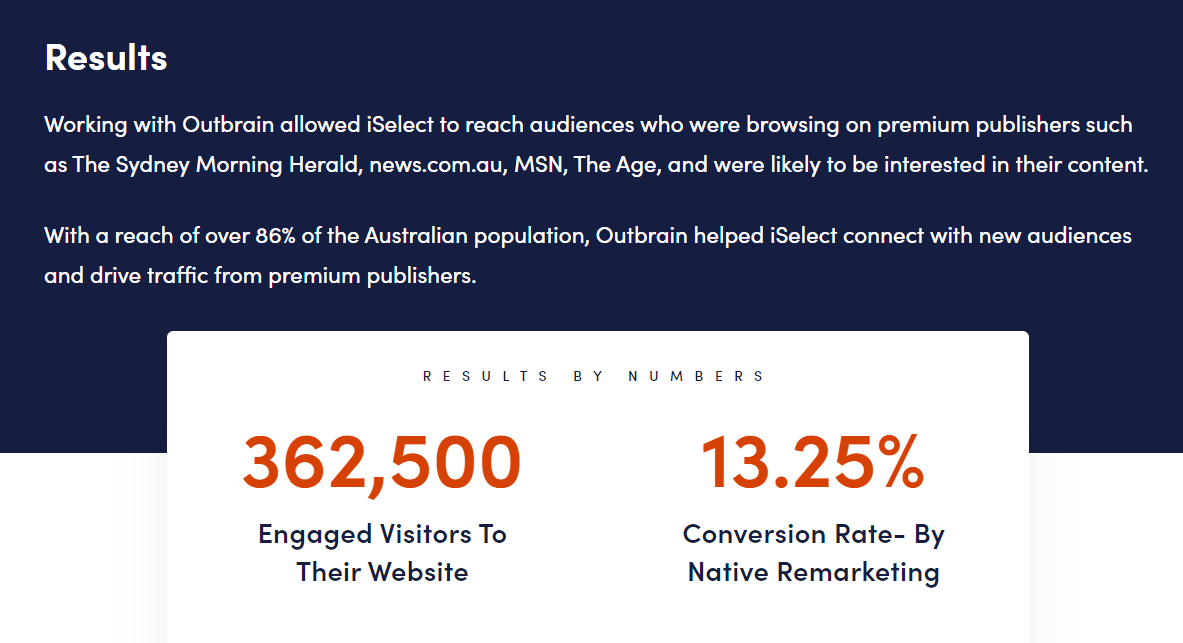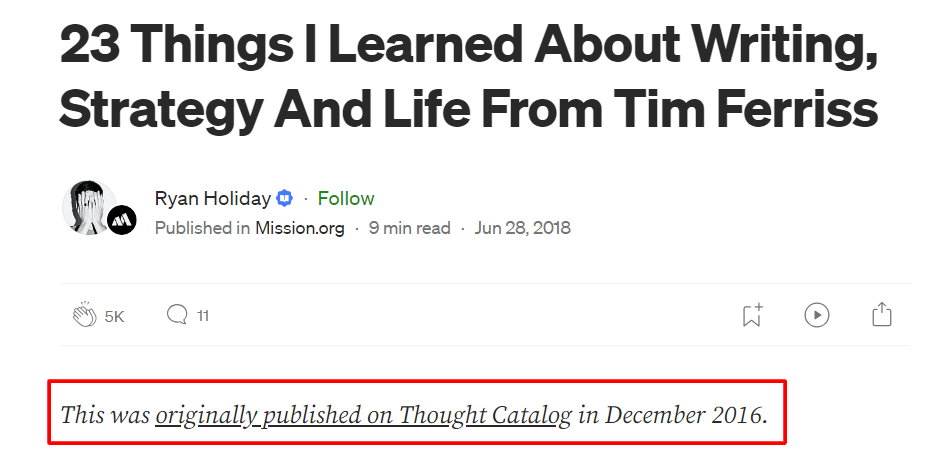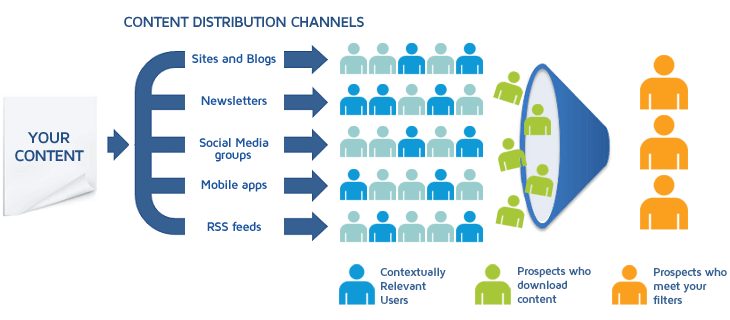Are you looking for a cost-effective B2B lead generation tactic that helps you deliver highly-qualified leads?
Then you should consider leveraging ABM content syndication.
Account-based marketing (ABM) flips traditional marketing on its head by focusing on a few strategic clients instead of casting a wide net. It helps you focus your marketing efforts on a few high-priority prospects instead of the masses.
When you apply that approach to your content syndication efforts, it takes your marketing to the next level.
In this post, we’ll discuss what ABM content syndication is and how it differs from regular content syndication. We’ll then give you a detailed step-by-step guide to using this brilliant marketing tactic to drive qualified leads for your business.
Let’s get started
What is ABM Content Syndication?
Content syndication is the process of distributing content on various channels to reach more people. ABM content syndication is a more targeted way to do so.
It requires creating tailored content for specific audiences (strategic accounts or customer segments) and distributing it on relevant channels.
Instead of trying to reach a wider audience, ABM content syndication involves distributing content to a carefully-selected audience segment. It doesn’t cast a wide net, but carefully-planned hooks for specific user accounts.
Why Should You Invest in ABM Content Syndication?
ABM content syndication uses a highly-targeted approach to marketing, which helps you win strategic clients, instead of amassing unqualified leads.
Here’s an illustration of how account-based marketing flips the marketing funnel by starting with a few high-priority accounts. And given that you target only relevant audiences, you generate highly-qualified leads that are ripe for nurturing and driving conversions.
And as per Content Marketing Institute’s analysis, account-based marketing campaigns deliver great results for B2B marketers.
How to Do ABM Content Syndication Right in 6 Steps
Follow this step-by-step process to use ABM content syndication to generate qualified leads for your business.
1. Identify your target accounts or audience segments
The first step is to identify high-value accounts or consumer segments that are most likely to turn into your clients. Prioritize the most important ones and dig deeper to get a better understanding of your chosen accounts and their key decision-makers.
Go beyond the demographics and understand their pain points, needs, and preferences.
Here are some tips to create and prioritize customer segments:
- Get insights from your sales team
Ask them who your most valuable customer are, what challenges they face, and what questions they ask about your products or services. Ask them about the common objections that prospects have that stop them from choosing your products or services over the competitors.
- Use account scoring and segmentation
Assign numerical values to each account based on various parameters that are relevant to your business. Some parameters you can use include:
- Account fit
- Revenue potential
- Industry
- Company size
- And more
Pro tip: You can use this best-fit accounts’ information to fuel your demand gen funnel with high-quality audience segments as well.
- Segment those accounts based on technographic and firmographic data
Segment accounts based on company-specific data, such as industry, annual revenue, size, etc. You can also create segments based on the tech stack a company uses and whether your product is a good fit.
- Prioritize accounts based on intent and behavioral signals
Monitor prospects’ online activities and interactions with your business to identify and prioritize accounts that are actively interested in your products or services.
Based on these insights, create Ideal Customer Profiles (ICP). Make them as detailed as possible to leverage them to identify highly-specific segments that you can target.
Here’s a template that you can use to create ICPs and account scoring:

2. Build a targeted content strategy
Once you have a clear idea of which accounts you want to target, create a targeted content strategy.
Use analytics and do your research to answer the following questions:
- Which types of content will work for your specific audience?
- What topics should you cover that would appeal to your target accounts?
- What answers are they looking for before making their purchase decision?
- What content can you use to convert your prospects into leads?
Based on this, create a detailed content strategy for ABM content syndication.
Use a mix of various content types to get the best results. For B2B ABM marketing, persuasive content, such as case studies, whitepapers, ebooks, and informative articles, is the most effective.
You can also use infographics and videos to convey more information about the topic and your products or services in an engaging format.
Here’s an extensive list of content types that you can use for content syndication:
Depending on how much time and effort you want to invest, you can choose different types of content for your content mix.
3. Choose the right ABM content syndication partners
The most important aspect of creating a successful ABM content syndication initiative is choosing the right syndication partners.
To cut things short: the key to success is finding publishers whose target audience matches yours.
Look beyond social media and popular content syndication platforms and find more industry-specific publishers.
While free syndication is great at keeping costs low, you may need to work with paid ABM syndication partners to get better results. If you’re working with paid syndication partners, choose the ones that provide you with intent data.
Here are some important parameters for vendor selection:
- In-depth data: Choose vendors that provide you access to a huge number of contacts. They should also provide data on behavior analytics, buyer intent, contact validation, technographic insights, and more.
- Segmentation: Vendors that offer advanced segmentation and can help your target specific audiences are preferable to generic ones.
- Performance measurement: Assess how a vendor measures performance and which metrics they track. Choose vendors that offer in-depth campaign performance reporting.
The success or failure of your content syndication efforts will depend on your choice of vendor. A good vendor can help you find the right publishers and help you showcase the right content to the right audiences.
Outbrain, for example, helped iSelect publish content on the right publishing channels and get 362K visitors to their website.
Similarly, we helped a fintech client generate qualified leads with higher conversion potential with our three-month ABM content syndication campaign.
4. Create and optimize content for syndication
Once you’ve chosen your content syndication vendors and platforms, it’s time to create engaging and relevant content to engage your target accounts.
Start with doing in-depth keyword research to find the right topics and keywords. Create SEO-friendly content rich with your selected keywords.
When sharing the same content on multiple channels, make sure you follow the guidelines and optimize content for each channel.
Also, ensure that the publishers use “rel=canonical” tags for republished content to avoid content duplication issues.
If a publisher requires you to disclose the fact that you are republishing a piece of content, do so using their preferred format. Some syndication platforms, such as Medium, ask you to mention where the post was originally published, along with a link to the original post.
Here’s an example of a republished article that clearly discloses when and where it was originally published:

5. Make sure you have a lead nurturing strategy in place
All your ABM content syndication efforts will fail if you don’t have a lead nurturing strategy in place.
You’ve defined your target audience, created and shared relevant content, and directed leads to your website. Great!
But what next? How will you convert these leads into clients or get them to take the next step?
You need to use forms and landing pages for that. These will help you capture lead information and nurture them further using tactics like email marketing and tele marketing.
Here’s a visual representation of an ABM content syndication funnel:
You need to use lead nurturing to drive the leads your ABM content syndication campaign generates down the funnel. Next, you need to quickly connect with these leads and build a relationship and emails are a great way to do that.
Check out this email by Gallup, which is automatically sent when someone downloads their report. It’s a perfect example of using content to bring in leads and using emails to nurture them.
6. Track the performance of your syndicated content and refine your approach
Your content syndication efforts do not end until you measure your performance and refine your strategy.
Assess which channels are working well for you and helping you generate the most qualified leads. Also, identify your top-performing content pieces and focus more on the types of content that perform well.
Understand that this is an ongoing process and assessing your performance will help you gain valuable insights into what works for you and what doesn’t.
Ready to Leverage ABM Content Syndication for Your Business?
By combining the power of account-based marketing with content syndication you can reach your top prospects through personalized content. ABM content syndication goes beyond basic B2B lead generation tactics and helps you win big-ticket clients.
Follow the step-by-step process explained in this guide to optimize your content syndication strategy and generate highly-qualified leads for your business.
Start scoring and shortlisting key accounts to start the ABM content syndication process or you can also hire professional content syndication services. All the best!





